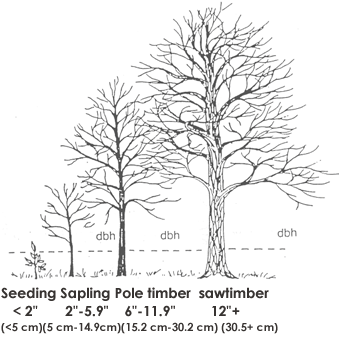
The Maryland Envirothon Forestry Resource Site Silviculture
This is an online study guide for advisors and students participating in the Maryland State Envirothon competition. It is not inclusive of all content you may need to know for the state competition. Web sites provided are for reference only and may not be exactly what students are tested on.
Introduction:
Silviculture is considered both an art and a science. In fact, you may find as many definitions of the term as foresters who practice it! If you major in forestry in college, you can expect to take several semester-long courses studying Silviculture. For Envirothon, let’s look at several definitions found in books on the subject:
- “The art and science of controlling the establishment, growth, composition, health, and quality of forests and woodlands to meet the diverse needs and values of landowners and society on a sustainable basis.”
- “The science of producing and tending a forest, from regeneration to harvesting. It addresses the biological, ecological, and economic aspects – both short and long term.”
- “The art, science, and practice of establishing, tending, and reproducing forest stands with desired characteristics.”
Among these definitions, three themes stand out: trees, environment, and people. Because trees are renewable and sustainable resources, and we depend on literally thousands of forest products every day, Silviculture represents the “how” and “why” our forests sustain an ever-growing need for forest products balanced with our need to conserve and protect habitat, soils, water quality, and air quality.
Learning Objectives:
At the end of this section you should:
- Understand the definition and concept of a forest stand as it relates to silvicultural practices.
- Be able to recognize and identify crown classes in a forest stand.
- Be able to identify and understand Intermediate harvest treatments and Regeneration harvest treatments.
- Understand the important role Silviculture plays in producing a renewable and sustainable forest resource and conserving Maryland’s diverse forest ecosystems.
- Be able to identify even-aged stands and un-even aged stands
Let’s Get Started:
As mentioned earlier, silviculture is both an art and a science. The professional forester engages in the art of silviculture by applying sound forest management techniques to help meet the landowner’s objectives, which may be timber production, wildlife habitat conservation, recreation, watershed protection, or a combination of all of these objectives.
The forester applies the science of silviculture after collecting the same forest measurement data that we learned to collect in the Forest Measurements section. Factors such as species composition, stocking levels, site index, basal area, volume and soils are used to make informed science-based decisions about implementing silvicultural practices. Let’s take a look at some important principles:
-
Height growth of trees is generally a function of species and site. By nature, certain species grow taller than others, and the site (the combination of biotic, climatic, topographic, and soil conditions of an area) the tree grows on influences its height.
-
Diameter growth of trees is a function of competition for water, sunlight, and nutrients. For example, an increment core taken from a tree five or ten years after a forest thinning will show a significant increase in the space between growth rings, indicating the tree is increasing its diameter as a result of reduced competition.
-
Stand: A basic concept of forestry, a stand is a grouping of trees of sufficiently uniform species composition, age, and condition to be distinguished from surrounding stands and managed as a single unit.
-
Even-aged Stand: A stand of trees that is relatively the same age. In Maryland, pine is most often managed with this technique by harvesting all of the trees and replanting within a short period of time.
-
Uneven-aged Stand: A group of trees of a variety of ages and sizes growing together on a uniform site.
Silvicultural Techniques:
Let’s look at some basic silvicultural systems: Intermediate Treatments, and Regeneration Treatments:
INTERMEDIATE TREATMENTS – Are any manipulation of a young forest to ensure the desired stand composition, spacing, stem quality, and growth performance might otherwise have been lost if the forest had been left to develop on its own. There are more than a half-dozen intermediate treatments foresters prescribe, but we’re only going to look at two:
-
Thinning – A thinning is usually performed in even-aged stands with the primary goal of redistributing growth potential to the “crop” trees (the trees you want to remain) or to benefit the quality of the remaining stand. There are several different techniques used for thinning, but all are designed to create more sunlight, water, and food for the remaining stand while generating forest products and income.

Thinning an Even-Aged Stand
-
Crop Tree Release - Often prescribed in uneven-aged hardwood stands with trees that are 12” (30.4 cm) or more in diameter, the selected crop trees are “released” by felling or girdling (cutting into the cambium around the tree to kill it, creating habitat for wildlife) those trees that compete with the crop tree. This practice is accomplished by locating “crop trees” at a fairly uniform spacing throughout the stand. Crop trees should have a healthy crown, be a species of potentially high value, and produce mast (seeds, nuts, or fruit for wildlife). 25 to 35 crop trees per acre (.4 hectares) should remain after releasing, this will space crop trees about 35 to 45 feet (10.5 m to 13.5 m) apart. Competing trees that have crowns that touch – or nearly touch – the crown of the crop tree should be released. Remove trees on at least three sides of the crop tree. Trees that are removed should be utilized for products such as pulpwood, firewood, or lumber.

Examples of Crop-Tree Release Techniques
REGENERATION TREATMENTS – Have the ultimate goal of removing the existing forest stand and planning for the reestablishment of the forest either through natural regeneration (using existing seed deposited in the forest soil or sprouts) or artificial regeneration (tree planting). Again, there are several regeneration treatments foresters prescribe to ensure healthy and sustainable forests, but let’s look at three:
-
Seed Tree Method - This technique removes all of the existing trees down to 2 inches (5.0 cm) in diameter, leaving mature “seed” trees to repopulate the site. Generally 8-20 seed trees per acre (.4 hectares) are left after the harvest, and are usually of a single species. Seed trees are selected prior to the harvest and are the most dominant, well-formed trees in the stand. In Maryland, loblolly pine is often regenerated by this method because the winged pine seeds are scattered by the wind. Once a successful crop of trees has been regenerated on the site, the seed trees should be removed in a second harvest.

Seed Tree Harvest
-
Clearcut Method - The purpose of the clearcut harvesting method is to promote the regeneration of shade intolerant species (young trees that require full sunlight) by creating openings at least 1 acre (.4 hectares) in size by removing all trees down to two inches (5.0 cm). Regeneration following a clearcut is very rapid and prolific, because it maximizes the site’s ability to naturally reproduce the forest. In Maryland, site preparation often follows a clearcut harvest to remove logging slash (residual branches and other brush) by prescribed burning, herbicide spraying, or using a bulldozer to push slash into windrows to create wildlife habitat. If the Seed Tree method is not used, artificial regeneration (reforestation planted by a crew or machine) may be used.

Clearcut Harvest with Wildlife Snags
-
Single Tree Selection Method - Under this system, single trees are marked for removal. The goal of this method is to maintain a self-sustaining forest of multiple age classes. Cutting a specific number of trees in each size class controls the structure of the forest, and the cutting pattern is repeated at regular intervals throughout the stand “rotation”. The objective of this method is to create an uneven age forest while maintaining a continuous forest cover. This uneven age management system favors the reproduction of shade tolerant (young trees that grow well in the shade of larger trees) species. In Maryland, these species include American beech, sugar maple, hemlock, dogwood, red maple, and black gum. In oak-dominated forest types, the uneven aged management system is generally not recommended.

Single Tree Selection Harvest
About Crown Classes…
In a forest community, trees occupy different positions in the canopy and understory. These positions can be referred to as crown classes and the ability to identify them, and the species that they are composed of, is key to making sound silvicultural decisions. Crown classes are identified as:
- Dominant – Trees receive full sunlight from above and the sides. In even-aged stands, dominant trees are often shade intolerant species. In Maryland, the species would include loblolly pine, Virginia pine, black walnut, yellow poplar, sycamore, green ash, black oak, scarlet oak, and others.
- Co-dominant – Trees receive full sunlight from above and partial sunlight from the sides. In Maryland, species that are moderately tolerant include white pine, hickory, yellow birch, red oak, white oak, black cherry, red cedar, and others.
- Intermediate – Receive partial sunlight from above and sides. Intermediate trees include any of the above species, and may become dominant or co-dominant in the event of the loss of the dominant tree through harvesting, weather-related event, disease, or fire.
- Suppressed - Trees receive only partial sunlight from above. In even-aged stands, species are usually shade tolerant or “understory” trees. In Maryland, species include hemlock, American beech, sugar maple, red maple, dogwood, American holly, redbud, dogwood, and others.

Crown Classes (D) Dominant, (CD) Co-Dominant, (I) Intermediate, And (S) Suppressed
About Size Classes…
Foresters classify trees into various size classes when conducting inventories of forest stands. When conducting a sample plot using the various forestry tools described in the measurements section, the species, size class, site index, and volume (often in logs or sticks) is noted on a tally sheet. This inventory process is often called cruising timber. The following size classes are used:

Putting It All Together…
After collecting forest data through measurements and studying the property, a forester may make the following decisions…

Summary…
As you can see, silviculture is both an art and a science. After data is collected using the various tools and tables found in the forest measurements section, that data is used to make decisions on implementing silvicultural techniques. Because private landowners own seventy-six percent of Maryland’s forest, these decisions are often based on the landowner’s management objectives, or what outcomes they want to accomplish by participating in a Forest Stewardship program.